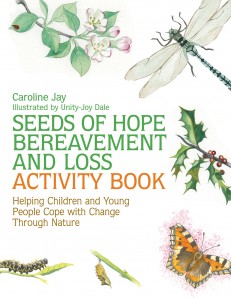Caroline Jay founded and runs the Seeds of Hope Children’s Garden, a national charity which aims to promote the use of nature in helping children manage loss. For twelve years she ran a SAND (Stillbirth and Neonatal Death Charity) group, supporting families after the death of a baby. We spoke to Caroline about using life cycles to teach children about change, how nature can help us come to terms with loss, and how her own experiences inspired her to write her new book, Seeds of Hope Bereavement and Loss Activity Book.
What inspired you to write the book?
A love of Nature and of being outside in the sun and air has been my inspiration for the Seeds of Hope Activity Book – that and the realisation that so much in Nature echoes the changes that happen in life. None of us can live life without change. All change implies loss and new beginnings – and this is a pattern ever present in Nature.
In your book, you use life cycles in Nature as a means of explaining death. Why did you choose that particular method?
Mainly because life cycles are fun! How amazing to see frogspawn turn into tadpoles that then turn into frogs! Or a grub become a caterpillar that disappears into a chrysalis out of which bursts a butterfly! Also because looking at the lifecycles that happen all the time in Nature can help us understand that change and loss are part of a natural order. “Death is a part of life is a part of death is a part of life is …” and so on as the circle turns. A seed becomes a plant that becomes a flower that becomes a fruit that contains the seed from which a new plant will grow. A baby becomes a child who becomes an adult who becomes an old person who will eventually die as new babies are born. The 4 stages of the life cycle in Nature reflect the 4 stages of a human life. The pattern continues: there are 4 seasons in the year, 4 weeks in the month, 4 quarters in the year.
Have you found yourself applying the methods you describe in the book in your own personal life? Have they been helpful?
When my first child, Laura was stillborn, I found myself completely out of balance. My hospital notes said I was a mother but I had no child. The world around me seemed suddenly full of babies and heavily pregnant women. The pain of grief was palpable. I took long walks in the woods. I found contact with Nature and the outside world to be immensely healing and grounding at a time when my world had been turned upside down. Grief for most people can be a very dark place. Planting seeds or plants and watching them grow in the Spring after the darkness of Winter can be uplifting and provide some hope of brighter times to come.
Does the grieving process for children and adults differ greatly?
The huge range of emotions we may feel when grieving – sadness, anger, shock, disbelief, fear, guilt, numbness to name a few – are generally speaking the same for children and adults. One difference is that children are usually only able to stay with their feelings for short periods of time – a bit like jumping in and out of a puddle, they may be very sad one minute and want to go out and play the next. Adults will generally have easier and clearer access to the information surrounding a death or a loss whereas children will generally be dependent on the adults around them to tell them the facts. It is a natural instinct to want to protect children from painful life experiences but, in the case of a death, this can lead to confusion. Children fare better when they are given honest information.
What has your experience with SAND and the Seeds of Hope Children’s Garden taught you about how people deal with loss?
Everybody responds to loss and bereavement in different ways. There is no right and wrong way to travel the road and there are no shortcuts. Very generally speaking men and women tend to grieve differently in that women are inclined to want to talk about their feelings for longer while men are more inclined to want to take action to restore the status quo. Partners, whether male or female, often grieve in different ways and at different speeds. In the case of a child’s death, the loss is equal and therefore no one person is better able to support the other. Some seek out a support group while others prefer to grieve privately.
How do you hope your book will make a difference?
The activities in the book serve to provide structure for and clarify the grief process for a child allowing them to see the natural process of the cycle of life in Nature. The images encourage exploration and observation of creatures, plants, and seasons. The way in which a child’s journey through grief is handled will fundamentally determine how they manage all future losses in adulthood. I hope the Seeds of Hope Activity Book will empower children to explore their feelings in ways they can understand – by drawing, playing, exploring and having fun.
You can find our more about Caroline’s book, read reviews or order your copy here.